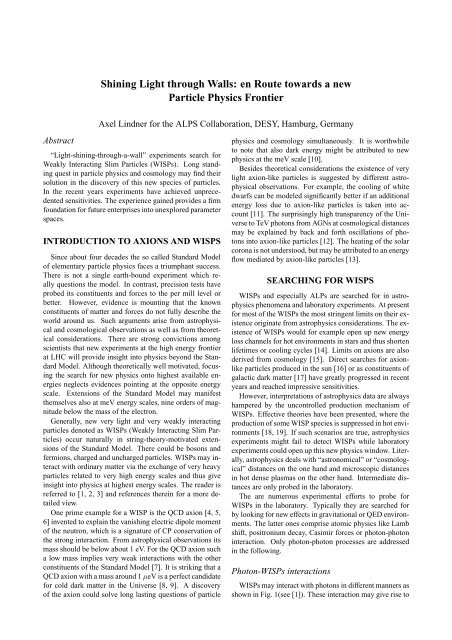Proceedings of International Conference on Physics in ... - KEK
Proceedings of International Conference on Physics in ... - KEK
Proceedings of International Conference on Physics in ... - KEK
You also want an ePaper? Increase the reach of your titles
YUMPU automatically turns print PDFs into web optimized ePapers that Google loves.
Abstract<br />
Sh<strong>in</strong><strong>in</strong>g Light through Walls: en Route towards a new<br />
Particle <strong>Physics</strong> Fr<strong>on</strong>tier<br />
Axel L<strong>in</strong>dner for the ALPS Collaborati<strong>on</strong>, DESY, Hamburg, Germany<br />
“Light-sh<strong>in</strong><strong>in</strong>g-through-a-wall” experiments search for<br />
Weakly Interact<strong>in</strong>g Slim Particles (WISPs). L<strong>on</strong>g stand<strong>in</strong>g<br />
quest <strong>in</strong> particle physics and cosmology may f<strong>in</strong>d their<br />
soluti<strong>on</strong> <strong>in</strong> the discovery <str<strong>on</strong>g>of</str<strong>on</strong>g> this new species <str<strong>on</strong>g>of</str<strong>on</strong>g> particles.<br />
In the recent years experiments have achieved unprecedented<br />
sensitivities. The experience ga<strong>in</strong>ed provides a firm<br />
foundati<strong>on</strong> for future enterprises <strong>in</strong>to unexplored parameter<br />
spaces.<br />
INTRODUCTION TO AXIONS AND WISPS<br />
S<strong>in</strong>ce about four decades the so called Standard Model<br />
<str<strong>on</strong>g>of</str<strong>on</strong>g> elementary particle physics faces a triumphant success.<br />
There is not a s<strong>in</strong>gle earth-bound experiment which really<br />
questi<strong>on</strong>s the model. In c<strong>on</strong>trast, precisi<strong>on</strong> tests have<br />
probed its c<strong>on</strong>stituents and forces to the per mill level or<br />
better. However, evidence is mount<strong>in</strong>g that the known<br />
c<strong>on</strong>stituents <str<strong>on</strong>g>of</str<strong>on</strong>g> matter and forces do not fully describe the<br />
world around us. Such arguments arise from astrophysical<br />
and cosmological observati<strong>on</strong>s as well as from theoretical<br />
c<strong>on</strong>siderati<strong>on</strong>s. There are str<strong>on</strong>g c<strong>on</strong>victi<strong>on</strong>s am<strong>on</strong>g<br />
scientists that new experiments at the high energy fr<strong>on</strong>tier<br />
at LHC will provide <strong>in</strong>sight <strong>in</strong>to physics bey<strong>on</strong>d the Standard<br />
Model. Although theoretically well motivated, focus<strong>in</strong>g<br />
the search for new physics <strong>on</strong>to highest available energies<br />
neglects evidences po<strong>in</strong>t<strong>in</strong>g at the opposite energy<br />
scale. Extensi<strong>on</strong>s <str<strong>on</strong>g>of</str<strong>on</strong>g> the Standard Model may manifest<br />
themselves also at meV energy scales, n<strong>in</strong>e orders <str<strong>on</strong>g>of</str<strong>on</strong>g> magnitude<br />
below the mass <str<strong>on</strong>g>of</str<strong>on</strong>g> the electr<strong>on</strong>.<br />
Generally, new very light and very weakly <strong>in</strong>teract<strong>in</strong>g<br />
particles denoted as WISPs (Weakly Interact<strong>in</strong>g Slim Particles)<br />
occur naturally <strong>in</strong> str<strong>in</strong>g-theory-motivated extensi<strong>on</strong>s<br />
<str<strong>on</strong>g>of</str<strong>on</strong>g> the Standard Model. There could be bos<strong>on</strong>s and<br />
fermi<strong>on</strong>s, charged and uncharged particles. WISPs may <strong>in</strong>teract<br />
with ord<strong>in</strong>ary matter via the exchange <str<strong>on</strong>g>of</str<strong>on</strong>g> very heavy<br />
particles related to very high energy scales and thus give<br />
<strong>in</strong>sight <strong>in</strong>to physics at highest energy scales. The reader is<br />
referred to [1, 2, 3] and references there<strong>in</strong> for a more detailed<br />
view.<br />
One prime example for a WISP is the QCD axi<strong>on</strong> [4, 5,<br />
6] <strong>in</strong>vented to expla<strong>in</strong> the vanish<strong>in</strong>g electric dipole moment<br />
<str<strong>on</strong>g>of</str<strong>on</strong>g> the neutr<strong>on</strong>, which is a signature <str<strong>on</strong>g>of</str<strong>on</strong>g> CP c<strong>on</strong>servati<strong>on</strong> <str<strong>on</strong>g>of</str<strong>on</strong>g><br />
the str<strong>on</strong>g <strong>in</strong>teracti<strong>on</strong>. From astrophysical observati<strong>on</strong>s its<br />
mass should be below about 1 eV. For the QCD axi<strong>on</strong> such<br />
a low mass implies very weak <strong>in</strong>teracti<strong>on</strong>s with the other<br />
c<strong>on</strong>stituents <str<strong>on</strong>g>of</str<strong>on</strong>g> the Standard Model [7]. It is strik<strong>in</strong>g that a<br />
QCD axi<strong>on</strong> with a mass around 1 µeV is a perfect candidate<br />
for cold dark matter <strong>in</strong> the Universe [8, 9]. A discovery<br />
<str<strong>on</strong>g>of</str<strong>on</strong>g> the axi<strong>on</strong> could solve l<strong>on</strong>g last<strong>in</strong>g questi<strong>on</strong>s <str<strong>on</strong>g>of</str<strong>on</strong>g> particle<br />
physics and cosmology simultaneously. It is worthwhile<br />
to note that also dark energy might be attributed to new<br />
physics at the meV scale [10].<br />
Besides theoretical c<strong>on</strong>siderati<strong>on</strong>s the existence <str<strong>on</strong>g>of</str<strong>on</strong>g> very<br />
light axi<strong>on</strong>-like particles is suggested by different astrophysical<br />
observati<strong>on</strong>s. For example, the cool<strong>in</strong>g <str<strong>on</strong>g>of</str<strong>on</strong>g> white<br />
dwarfs can be modeled significantly better if an additi<strong>on</strong>al<br />
energy loss due to axi<strong>on</strong>-like particles is taken <strong>in</strong>to account<br />
[11]. The surpris<strong>in</strong>gly high transparency <str<strong>on</strong>g>of</str<strong>on</strong>g> the Universe<br />
to TeV phot<strong>on</strong>s from AGNs at cosmological distances<br />
may be expla<strong>in</strong>ed by back and forth oscillati<strong>on</strong>s <str<strong>on</strong>g>of</str<strong>on</strong>g> phot<strong>on</strong>s<br />
<strong>in</strong>to axi<strong>on</strong>-like particles [12]. The heat<strong>in</strong>g <str<strong>on</strong>g>of</str<strong>on</strong>g> the solar<br />
cor<strong>on</strong>a is not understood, but may be attributed to an energy<br />
flow mediated by axi<strong>on</strong>-like particles [13].<br />
SEARCHING FOR WISPS<br />
WISPs and especially ALPs are searched for <strong>in</strong> astrophysics<br />
phenomena and laboratory experiments. At present<br />
for most <str<strong>on</strong>g>of</str<strong>on</strong>g> the WISPs the most str<strong>in</strong>gent limits <strong>on</strong> their existence<br />
orig<strong>in</strong>ate from astrophysics c<strong>on</strong>siderati<strong>on</strong>s. The existence<br />
<str<strong>on</strong>g>of</str<strong>on</strong>g> WISPs would for example open up new energy<br />
loss channels for hot envir<strong>on</strong>ments <strong>in</strong> stars and thus shorten<br />
lifetimes or cool<strong>in</strong>g cycles [14]. Limits <strong>on</strong> axi<strong>on</strong>s are also<br />
derived from cosmology [15]. Direct searches for axi<strong>on</strong>like<br />
particles produced <strong>in</strong> the sun [16] or as c<strong>on</strong>stituents <str<strong>on</strong>g>of</str<strong>on</strong>g><br />
galactic dark matter [17] have greatly progressed <strong>in</strong> recent<br />
years and reached impressive sensitivities.<br />
However, <strong>in</strong>terpretati<strong>on</strong>s <str<strong>on</strong>g>of</str<strong>on</strong>g> astrophysics data are always<br />
hampered by the unc<strong>on</strong>trolled producti<strong>on</strong> mechanism <str<strong>on</strong>g>of</str<strong>on</strong>g><br />
WISPs. Effective theories have been presented, where the<br />
producti<strong>on</strong> <str<strong>on</strong>g>of</str<strong>on</strong>g> some WISP species is suppressed <strong>in</strong> hot envir<strong>on</strong>ments<br />
[18, 19]. If such scenarios are true, astrophysics<br />
experiments might fail to detect WISPs while laboratory<br />
experiments could open up this new physics w<strong>in</strong>dow. Literally,<br />
astrophysics deals with “astr<strong>on</strong>omical” or “cosmological”<br />
distances <strong>on</strong> the <strong>on</strong>e hand and microscopic distances<br />
<strong>in</strong> hot dense plasmas <strong>on</strong> the other hand. Intermediate distances<br />
are <strong>on</strong>ly probed <strong>in</strong> the laboratory.<br />
The are numerous experimental efforts to probe for<br />
WISPs <strong>in</strong> the laboratory. Typically they are searched for<br />
by look<strong>in</strong>g for new effects <strong>in</strong> gravitati<strong>on</strong>al or QED envir<strong>on</strong>ments.<br />
The latter <strong>on</strong>es comprise atomic physics like Lamb<br />
shift, positr<strong>on</strong>ium decay, Casimir forces or phot<strong>on</strong>-phot<strong>on</strong><br />
<strong>in</strong>teracti<strong>on</strong>. Only phot<strong>on</strong>-phot<strong>on</strong> processes are addressed<br />
<strong>in</strong> the follow<strong>in</strong>g.<br />
Phot<strong>on</strong>-WISPs <strong>in</strong>teracti<strong>on</strong>s<br />
WISPs may <strong>in</strong>teract with phot<strong>on</strong>s <strong>in</strong> different manners as<br />
shown <strong>in</strong> Fig. 1(see [1]). These <strong>in</strong>teracti<strong>on</strong> may give rise to













